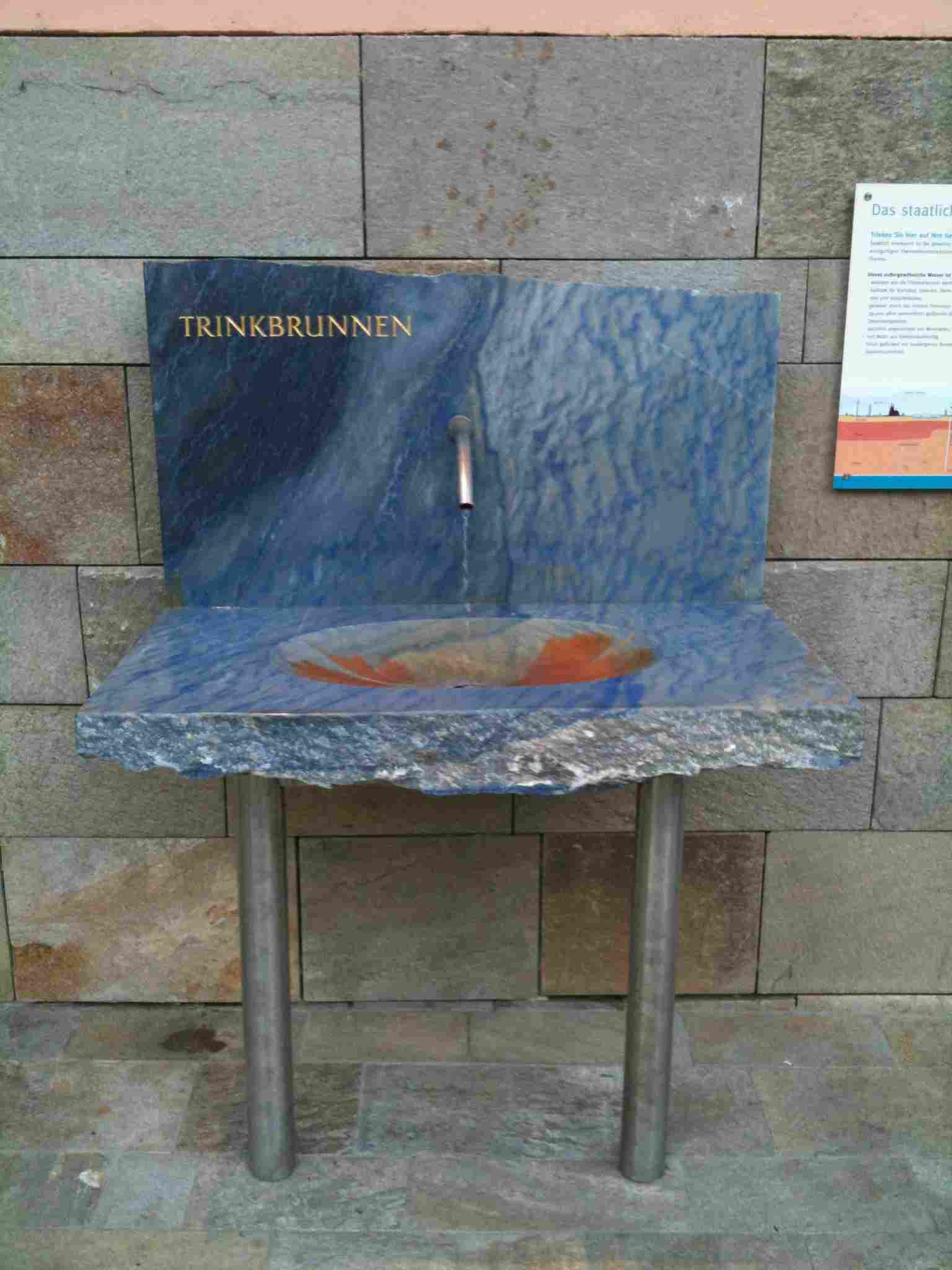Thermalquellen in Köln EarthCache
-
Difficulty:
-

-
Terrain:
-

Size:  (other)
(other)
Please note Use of geocaching.com services is subject to the terms and conditions
in our disclaimer.
Kölner Thermalquelle
Das in der Thermalquelle geförderte Mineralwasser hat einen langen Weg hinter sich: Niederschlagswasser versickert im Bereich des Bergischen Landes und fließt dem Gefälle des Kalk- und Dolomitgesteins (ca. 350 Mio. Jahre alt) folgend nach Westen, in Richtung Köln. Auf dem Weg dorthin heizt es sich durch den
Wärmestrom aus dem Erdinnern auf und wird somit zu Thermalwasser.
In großer Tiefe (300 bis 1500 m) mischt sich dieses warme Wasser mit deutlich chloridhaltigem Mineralwasser, welches wahrscheinlich mit den permischen Salzlagern des Niederrheingebiets in Verbindung steht. Durch die hier vorhandene freie Kohlensäure, die noch aus der Zeit des Laacher-See-Vulkanismus vor rund 11.000 Jahren stammt, entsteht schließlich der "thermale Natrium-Chlorid-Säuerling" der Kölner Therme.
Die Kohlensäure bewirkt als sogenannter Gaslift eine natürliche Aufstiegstendenz des Wassers, so dass dieses ohne größere Schwierigkeiten durch die 1961/62 und 1974-76 erbauten Messebrunnen III und IV gefördert werden kann. Köln bildet den nördlichsten Ausläufer der durch vulkanische Aktivität entstandenen "Kohlensäure-Linie", die am Laacher See beginnt und sich über Bad Breisig, Bad Honnef und Bad Godesberg erstreckt.
Die besondere geologische Struktur der Rheinischen Bucht und der Niederschlagsreichtum des Bergischen Landes bilden also vor dem Hintergrund des mittelrheinischen Vulkanismus in der erdgeschichtlichen Vergangenheit die Voraussetzungen für das einzigartige Kölner Thermalwasser. Dieses Wasser wird auf natürlichem Wege gebildet und kann angesichts der hohen Neubildungsrate bei gleichbleibender Qualität ohne Beeinträchtigung der geohydrologischen Bedingungen gefördert werden.
Chemische Untersuchung
In 1 kg des Wassers des "Messebrunnen III" in Köln sind enthalten
Kationen:
Natrium 3.757,00 mg Kalium 89,90 mg Ammonium 5,58 mg Magnesium 318,60 mg Calcium 608,10 mg Mangan(II) 0,69 mg Eisen 4,25 mg gesamt 4.783,82 mg
Anionen:
Chlorid-Ion 5.902,00 mg Sulfat 754,80 mg Hydrogencarbonat 2.471,00 mg gesamt 9.127,80 mg
Undissozierte Bestandteile: Kieselsäure 16,60 mg
Quelle: Betreiber der nahen Einrichtung

Um diesen Earthcache zu loggen, beantworte bitte folgende Fragen :
1. Der Untergrund der östlichen Kölner Erd-Scholle stammt aus geologischen Zeitabschnitten - wievielen Abschnitten ?
2. Die Thermalquelle enthält freies Kohlendioxid - welche Konzentration ?
3. Wie tief ist der Messebrunnen IV ?
4. Befragt das Internet und schreibt uns, wann die erste Thermalquelle in Köln im nahen Stammheim gefunden wurde ?
Macht ein Bild von Euch neben dem Brunnen bzw. legt einfach Euer GPS auf den Brunnenrand. Nach den neuesten Bestimmung ist das Bild natürlich freiwillig und keine Voraussetzung für den Log.
Schicke uns eine eMail über unser Profi mit deinen Antworten. Du kannst den Cache direkt loggen, falls etwas nicht stimmen sollte, werden wir uns bei Dir melden
Wie erfolgt die Logfreigabe bei einem EarthCache?
english version
The aided water has a long way: rainwater seeps in the area of the Bergisch County and flows to the slope of the limestone and dolomite rocks (about 350 million after years old) following the west in the direction of Cologne. Along the way it heats up through the Heat flow from the Earth's interior to and so it is thermal water.
In great depth (300-1500 m), this warm water mixed with much chloride containing mineral water, which is probably related to the Permian salt deposits of the Lower Rhine area in connection. By the presence of free carbon dioxide, which dates from the time of the Laacher-sea volcanic activity about 11,000 years ago, finally get the "thermal sodium chloride acidulous" Therme Cologne.
The carbonic acid causes a so-called gas lift is a natural tendency to rise of the water, so that this can be promoted without much difficulty by the 1961/62 and 1974-76 built fair fountain III and IV. Cologne is the northernmost spur of the damage caused by volcanic activity 'carbonic-line ", which begins on Laachersee and extends over Breisig Bad, Bad Honnef and Bad Godesberg.
The specific geological structure of the Rhenish Bight and the precipitation of the Bergisch land are so against the background of the middle Rhine volcanism in the geological past, the conditions for the unique thermal water of Cologne. This water will be formed in a natural way and can be promoted considering the high recharge rates at the same quality without affecting the conditions geohydrological.
Chemical analysis In 1 kg of water of the "fountain III" are included
Cations: Sodium potassium 89.90 mg 3757.00 mg 5.58 mg Magnesium 318.60 mg ammonium calcium 608.10 mg manganese (II) 0.69 mg iron 4.25 mg total 4783.82 mg
Anions: chloride ion sulphate 754.80 mg 5902.00 mg 2471.00 mg total bicarbonate 9127.80 mg Undissociated ingredients: silica 16.60 mg
Source: Operators of the nearby facility
To log this cache, we ask you the following information :
The surface of the eastern Cologne earth soil comes from geological times - how many sections?
2. The hot fount contains free carbon dioxide - which concentration?
3. How deep is the fountain IV?
4. Consulted the Internet and write us, when has the first hot spring was found in Cologne-Stammheim ?
Makes a picture of you next to the fountain or just place your GPS on the edge of the well of course optional and not required for the log.
Send us an email with your answers. You can log in directly to the cache, if anything happens to agree, we will contact you
As the log release takes place at an Earth Cache?
Additional Hints
(No hints available.)